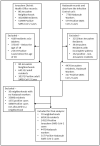Are Healthcare Workers Infected with SARS-CoV-2 at Home or at Work? A Comparative Prevalence Study
- PMID: 36232249
- PMCID: PMC9564591
- DOI: 10.3390/ijerph191912951
Are Healthcare Workers Infected with SARS-CoV-2 at Home or at Work? A Comparative Prevalence Study
Abstract
Prior to the widespread use of vaccinations, healthcare workers (HCWs) faced the double burden of caring for unprecedented numbers of critically ill COVID-19 patients while also facing the risk of becoming infected themselves either in healthcare facilities or at home. In order to assess whether SARS-CoV-2-positivity rates in HCWs reflected or differed from those in their residential areas, we compared the SARS-CoV-2-positivity rates during 2020 among HCWs in Hadassah Hebrew University Medical Centers (HHUMC), a tertiary medical center in Jerusalem, Israel, to those of the general population in Jerusalem, stratified by neighborhood. Additionally, we compared the demographic and professional parameters in every group. Four percent of the adult population (>18 years) in Jerusalem tested positive for SARS-CoV-2 during 2020 (24,529/605,426) compared to 7.1% of HHUMC HCWs (317/4470), rate ratio 1.75 (95% CI 1.57-1.95), with wide variability (range 0.38-25.0) among different neighborhoods. Of the 30 neighborhoods with more than 50 infected HCWs, 25 showed a higher positivity rate for HCWs compared to the general population. The higher risk of HCWs compared to residents representing the general population in most neighborhoods in Jerusalem may be explained by their behavior in and out of the hospital.
Keywords: COVID-19; SARS-CoV-2; healthcare workers; location; neighborhood; occupational risk.
Conflict of interest statement
The authors declare no conflict of interest.
Figures




Similar articles
-
High prevalence of SARS-CoV-2 infection among symptomatic healthcare workers in a large university tertiary hospital in São Paulo, Brazil.BMC Infect Dis. 2020 Dec 2;20(1):917. doi: 10.1186/s12879-020-05662-8. BMC Infect Dis. 2020. PMID: 33267836 Free PMC article.
-
Prevalence of SARS-CoV-2 infection and dynamics of antibodies response among previously undiagnosed healthcare workers in a university hospital: A prospective cohort study.J Infect Public Health. 2021 Oct;14(10):1466-1473. doi: 10.1016/j.jiph.2021.06.001. Epub 2021 Jun 10. J Infect Public Health. 2021. PMID: 34175238 Free PMC article.
-
Cross-sectional prevalence of SARS-CoV-2 antibodies in healthcare workers in paediatric facilities in eight countries.J Hosp Infect. 2021 Apr;110:60-66. doi: 10.1016/j.jhin.2020.12.019. Epub 2021 Jan 7. J Hosp Infect. 2021. PMID: 33422589 Free PMC article.
-
COVID-19 in Health-Care Workers: A Living Systematic Review and Meta-Analysis of Prevalence, Risk Factors, Clinical Characteristics, and Outcomes.Am J Epidemiol. 2021 Jan 4;190(1):161-175. doi: 10.1093/aje/kwaa191. Am J Epidemiol. 2021. PMID: 32870978 Free PMC article.
-
The seroprevalence of SARS-CoV-2 antibodies among health care workers before the era of vaccination: a systematic review and meta-analysis.Clin Microbiol Infect. 2021 Sep;27(9):1242-1249. doi: 10.1016/j.cmi.2021.05.036. Epub 2021 Jun 8. Clin Microbiol Infect. 2021. PMID: 34116205 Free PMC article.
Cited by
-
Clinical-Epidemiological Profile of Dental Professionals Associated with COVID-19 Infection in Southern Peru: A Cross-Sectional Study.Int J Environ Res Public Health. 2022 Dec 30;20(1):672. doi: 10.3390/ijerph20010672. Int J Environ Res Public Health. 2022. PMID: 36612988 Free PMC article.
-
Successful pandemic management through computer science: a case study of a financial corporation with workers on premises.Front Public Health. 2023 Nov 17;11:1208751. doi: 10.3389/fpubh.2023.1208751. eCollection 2023. Front Public Health. 2023. PMID: 38045981 Free PMC article.
-
Viral and Bacterial Respiratory Pathogens during the COVID-19 Pandemic in Israel.Microorganisms. 2023 Jan 9;11(1):166. doi: 10.3390/microorganisms11010166. Microorganisms. 2023. PMID: 36677458 Free PMC article.
References
-
- Centers for Disease Control and Prevention–CDC Coronavirus Disease 2019 (COVID-19) in the U.S. [Internet]. Centers for Disease Control and Prevention. [(accessed on 31 October 2020)];2020 Available online: https://www.cdc.gov/covid-data-tracker.
-
- Lai X., Wang M., Qin C., Tan L., Ran L., Chen D., Zhang H., Shang K., Xia C., Wang S., et al. Coronavirus Disease 2019 (COVID-2019) Infection Among Health Care Workers and Implications for Prevention Measures in a Tertiary Hospital in Wuhan, China. JAMA Netw. Open. 2020;3:e209666. doi: 10.1001/jamanetworkopen.2020.9666. - DOI - PMC - PubMed
-
- Houlihan C.F., Vora N., Byrne T., Lewer D., Kelly G., Heaney J., Gandhi S., Spyer M.J., Beale R., Cherepanov P., et al. Pandemic peak SARS-CoV-2 infection and seroconversion rates in London frontline health-care workers. Lancet. 2020;396:e6–e7. doi: 10.1016/S0140-6736(20)31484-7. - DOI - PMC - PubMed
-
- Spalanzani R.N., Genelhoud G., Raboni S.M., de Almeida S.M., Pereira L.A., Rotta I., Cavalli B.M., Moreira F.B., Dino C.L.T., Takahashi G.R.D.A., et al. Severe acute respiratory syndrome coronavirus 2 infection among healthcare workers in a tertiary public hospital in Curitiba, Brazil. Rev. Soc. Bras. Med. Trop. 2022;55:e0265. doi: 10.1590/0037-8682-0265-2021. - DOI - PMC - PubMed
MeSH terms
LinkOut - more resources
Full Text Sources
Medical
Miscellaneous

